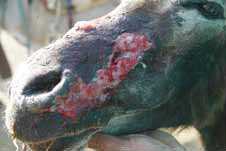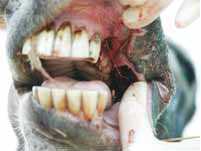Difference between revisions of "Complicated Wound - Donkey"
(New page: {{review}} '''Definition: a wound that has components of one or more of the other types that is complicated '''by factors that either preclude simple [[Healing Fundamentals - Donkey#Pr...) |
|||
| (3 intermediate revisions by the same user not shown) | |||
| Line 1: | Line 1: | ||
| − | {{ | + | {{review}} |
| − | + | ||
| − | + | '''Definition: a wound that has components of one or more of the other types that is complicated | |
| − | + | '''by factors that either preclude simple [[Healing Fundamentals - Donkey#Primary or first intention healing|primary union]] | |
| + | '''or are likely to result in serious delays in healing.''' | ||
[[Image:Facial injury.jpg|left|thumb|250px|<small><center>This facial injury was complicated by severe damage to the facial nerve resulting in facial paralysis and an oro-cutaneous-nasal fistula (direct communication between the skin wound and the mouth and nasal cavity). The wound had been in existence for some 10 days before presentation and the bone underlying the wound was necrotic. There were therefore significant complications and reasons why the wound was likely to heal slowly, if at all. (Image courtesy of [http://drupal.thedonkeysanctuary.org.uk The Donkey Sanctuary])</center></small>]] | [[Image:Facial injury.jpg|left|thumb|250px|<small><center>This facial injury was complicated by severe damage to the facial nerve resulting in facial paralysis and an oro-cutaneous-nasal fistula (direct communication between the skin wound and the mouth and nasal cavity). The wound had been in existence for some 10 days before presentation and the bone underlying the wound was necrotic. There were therefore significant complications and reasons why the wound was likely to heal slowly, if at all. (Image courtesy of [http://drupal.thedonkeysanctuary.org.uk The Donkey Sanctuary])</center></small>]] | ||
| Line 35: | Line 36: | ||
|linkpage =Wound Types - Donkey | |linkpage =Wound Types - Donkey | ||
|linktext =Wound Types - Donkey | |linktext =Wound Types - Donkey | ||
| + | |rspace={{Donkey}} | ||
|pagetype=Donkey | |pagetype=Donkey | ||
}} | }} | ||
| − | |||
| − | |||
| − | |||
| − | |||
| − | |||
| − | |||
Revision as of 12:19, 20 February 2010
| This article has been peer reviewed but is awaiting expert review. If you would like to help with this, please see more information about expert reviewing. |
Definition: a wound that has components of one or more of the other types that is complicated by factors that either preclude simple primary union or are likely to result in serious delays in healing.


Complicated wounds are commonly seen in equine practice. The management of complicated wounds is always problematic. Some require careful anatomical reconstruction and others require various other techniques. In all cases the wound management procedure must be followed carefully.
Initially the wound must be protected from further damage until a detailed exploration can be performed. For this reason it is common practice to apply a hydrogel and a dressing while the animal is moved to a suitable facility. Involvement of other organs or structures may be more significant than the skin injury itself. One of the most critical factors is a full exploration of the wound. In some cases this can be performed with the sedated standing animal but in others a general anaesthetic is advisable. The extent of the injuries may mean that the skin wounds are insignificant (e.g. compound fractures of the limb bone, open body cavities, etc).
Healing depends on the extent of damage and ability of the structures involved to heal.
References
- Knottenbelt, D. (2008) The principles and practice of wound mamagement In Svendsen, E.D., Duncan, J. and Hadrill, D. (2008) The Professional Handbook of the Donkey, 4th edition, Whittet Books, Chapter 9
|
|